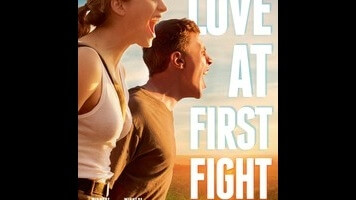Two army trainees (very) slowly fall for each other in Love At First Fight

In its native France, Love At First Fight was released as The Fighters. The U.S. title is cutesy, but not inaccurate. The movie does turn the romance trope of a couple resisting their immediate attraction via bickering into an actual physical altercation: Arnaud (Kévin Azaïs) meets Madeleine (Adèle Haenel) in a brief grapple during a self-defense demonstration organized by the French army. As the film opens, recruiters are everywhere, trying to catch young people from small French towns in between commitments. Though it’s not immediately clear whether Arnaud and his friends have just finished high school or college, director/co-writer Thomas Cailley establishes a mood of post-grad ennui; actual storm clouds gather in several early scenes. One of Arnaud’s friends makes it explicit: “France is dead. There’s no future here.”
The unsmiling and standoffish Madeleine goes even further; she predicts that the end of the world is coming. Given her vague goal of preparing to survive whatever apocalypse hits first, she plans to join a particularly rigorous branch of the army. Arnaud, less focused on preparedness, encounters her again at his planned summer job, building sheds with his brother Manu (Antoine Laurent). She doesn’t encourage the advances that he barely makes, but neither of them can bring themselves to ignore the other entirely. Much of the movie’s romance—and this is a romance, albeit an uncommonly patient one—depends on small gestures or, in some cases, the lack thereof. During the kind of rainstorm that sends Nicholas Sparks lovers into passionate clinches, Arnaud and Madeleine consider taking additional practice punches at each other, then back away.
The film, similarly, never moves in too close. Cailley uses following and backward tracking shots to keep the characters’ environment clear and visible. When Arnaud asks Madeleine on a kinda-sorta date, the scene is filmed entirely in an extreme wide shot, with the characters’ faces too far away to register. The editing within scenes is patient (the whole movie is patient; strictly speaking, not that much happens in it), but Cailley and editor Lilian Corbeille get in and out of those scenes with real snap. They show ennui without succumbing to it; their movie has the crispiness of romantic comedy, even though it’s lacking almost entirely in rom-com signifiers like witty banter, romantic declarations, or even many actual laughs. The conflicts between the two leads are blunt with only hints of playfulness. “Tell me one thing you like,” Arnaud challenges Madeleine. The best she can do is convey an affectionate tolerance of dogs.
Madeleine could at any moment turn into a real pill to be around—when she finally gets to an army training course (joined by Arnaud, who refers to it as “summer camp”), for example, she has plenty of dissatisfied and sometimes nitpicky questions about the methodology of her training. But Haenel, with her wonderfully pitiless stare, imbues her with a sense of principle, however abstract or vague, and Azaïs underplays just enough to seem quietly in awe of her without seeming completely cowed. Love At First Fight does hold more tension in its earlier moments, when Haenel and Azaïs warily circle both each other and the faint idea of surviving their adult lives. In its back half, the leads make their way into a strange sort of Badlands-like idyll before an abrupt (if mostly earned) ending; the last 40 minutes are somehow both more eventful and slower than what preceded them. Even when it’s slowing down, Fight shows beguiling confidence in both its filmmaking and its characters—enough to make its smallest romantic moments feel significant.